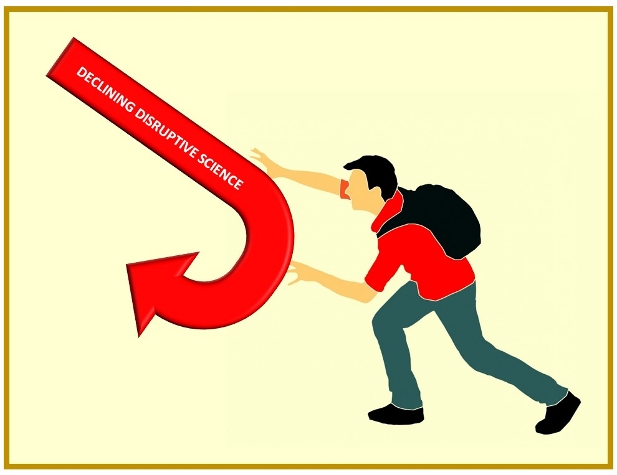A recent publication[1] after analyzing data on 45 million papers and 3.9 million patents over more than 60 years has revealed that research increasingly consolidates and develops existing knowledge rather than disrupting human understanding. The researchers discovered that there has been a significant decline in the words that are used to create a new paradigm and increase in the words that referred to existing paradigm. This is a serious concern for the future progress of science, because this decline of disruptiveness has occurred despite large increases in scientific productivity and increase in the number of papers and patents.
Therefore, “the decline represents a substantive shift in science and technology, one that reinforces concerns about slowing innovative activity.”
Figure source[1]: Decline of disruptive science and technology

Growing our knowledge by studying the past discoveries have led to this increase in scientific productivity. However, the narrowing focus, aka specializations, have resulted in less diverse and only incremental changes in those fields.
Although we do emphasize creativity, it seems to be associated with artistic expressions and out-of-the-box thinking. Creativity in science is not a well-known factor. The fact is science is creative in much the same way as arts. According to Albert Einstein, “Creativity is intelligence having fun.” Creativity is not only a skill but also an attitude that everyone needs to learn.
Thinking outside the box is the ability to come up with new and unusual ideas. Everyone is born with this creative ability; however, we learn to forget. The truth is that very few ideas are 100 percent original. The most brilliant (and often most profitable) business ideas are usually variations of an already existing theme rather than completely new concepts.
Our education and social systems are designed to help us gain knowledge of the past, rather than encourage and foster new discoveries and inventions. Being immersed in the past knowledge has created a widespread acceptance of that knowledge, further inhibited new ideas and created reluctance to challenge the status quo or question the experts.
However, the pursuit for new discovery and new ideas must never stop!
Today the notion is that learning must be in a structured setting and everything you need to know must be taught by someone else. This has reduced curiosity and self-motivation. Because of this, many students and even educators are unable to thrive in an open unstructured learning environment. Since we are deeply rooted in the old systems, a sudden change maybe too difficult for many. Which is why we need to enable this shift by creating new programs and opportunities. Such new programs must cultivate environments where one is most comfortable with unstructured self-learning, and promote a cultural change that encourages curiosity, exploration, creativity, and risks.
“Progress in science depends on new techniques, new discoveries and new ideas, probably in that order” – Sydney Brenner, Nobel Laureate.
The Emerging Innovators Research Program incorporates both structured and unstructured environments. The program has three phases which teaches new techniques, builds the skills needed to make new discoveries and have new insights, and then guides through the process to apply the new insight to develop and design a solution to address a real-world problem.

A unique transformative program that creates disruptive thinkers capable of deciphering the problems to its root causes and discover new ideas and strategies from the vast uncharted territories of the natural world.
Reference:
- Park, M., Leahey, E. & Funk, R.J. Papers and patents are becoming less disruptive over time. Nature613, 138-144 (2023). https://doi.org/10.1038/s41586-022-05543-x
ABOUT THE AUTHOR:
Ms. Shanti Balaraman, President & CEO, Children’s Innovation Center
